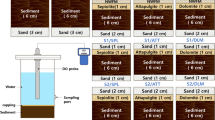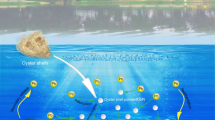Abstract
As phosphorus (P) exceeds 0.1 mg P L−1, the water is usually considered high enough to cause eutrophication. Thermally treated mussel shell (TMS), a calcium-rich (36.76%) biological material, was an environmentally friendly and low-cost adsorbent for P removal. To achieve very low concentrations of P, composite agents of PAC–TMS, Fe–TMS and La–TMS were prepared with the optimum weight ratio of 0.4, 0.2 and 0.2 (g g−1) [polyaluminium chloride (PAC), Fe(OH)3 or La2O3 to TMS] with the lower cost and high P adsorption efficiency, respectively, all of which had more than 80% of P removal rate after 12-h treatment of 5 mg L−1 P solution, much higher than that of TMS alone (50%). Isotherm experiment showed that these composite agents have maximum phosphate adsorption capacities of 91.74 mg P g−1 (PAC–TMS), 101.42 mg P g−1 (Fe–TMS) and 56.50 mg P g−1 (La–TMS), respectively. Additionally, the metal-modified TMS was almost independent of pH. Long-term efficient removal of P (< 0.1 mg L−1) was achieved during a 3-month removal trial of P-contaminated water while using these metal-modified TMS. Since metal-modified TMS both had calcium and other multivalent metal (Al, La or Fe), the modification pathway was mainly dependent on both enhance adsorption/precipitation by a simultaneous effect of the calcium and other multivalent metal.
Article Highlights
-
PAC–TMS, Fe–TMS and La–TMS with optimum ratio of 0.4, 0.2 and 0.2 for P removal
-
P adsorption capacities of 91.74(PAC–TMS), 101.42(Fe–TMS) and 56.50 mg g−1 (La–TMS)
-
Long-term efficient removal of P (< 0.1 mg L−1) via these metal-modified TMS





Similar content being viewed by others
References
Arulvel S, Elayaperumal A, Jagatheeshwaran MS (2017) Electroless nickel—phosphorus coating on crab shell particles and its characterization. J Solid State Chem 248:87–95
Boeykens SP, Piol MN, Samudio Legal L, Saralegui AB, Vázquez C (2017) Eutrophication decrease: phosphate adsorption processes in presence of nitrates. J Environ Manag 203:888–895
Chen N, Feng C, Zhang Z, Liu R, Gao Y, Li M, Sugiura N (2012) Preparation and characterization of lanthanum (III) loaded granular ceramic for phosphorus adsorption from aqueous solution. J Taiwan Inst Chem Eng 43(5):783–789
Dai L, Tan F, Li H, Zhu N, He M, Zhu Q, Hu G, Wang L, Zhao J (2017) Calcium-rich biochar from the pyrolysis of crab shell for phosphorus removal. J Environ Manag 198:70–74
Deng Y, Ruan Y, Ma B, Timmons MB, Lu H, Xu X, Zhao H, Yin X (2019) Multi-omics analysis reveals niche and fitness differences in typical denitrification microbial aggregations. Environ Int 132:105085
Huang W, Yu X, Tang J, Zhu Y, Zhang Y, Li D (2015) Enhanced adsorption of phosphate by flower-like mesoporous silica spheres loaded with lanthanum. Microporous Mesoporous Mater 217:225–232
Karageorgiou K, Paschalis M, Anastassakis GN (2007) Removal of phosphate species from solution by adsorption onto calcite used as natural adsorbent. J Hazard Mater 139(3):447–452
Kumar SP, Korving L, van Loosdrecht M, Witkamp GJ (2019) Adsorption as a technology to achieve ultra-low concentrations of phosphate: research gaps and economic analysis. Water Res X 4:100029
Lin L, Li Z, Song X, Jiao Y, Zhou C (2018) Preparation of chitosan/lanthanum hydroxide composite aerogel beads for higher phosphorus adsorption. Mater Lett 218:201–204
Micháleková-Richveisová B, Frišták V, Pipíška M, Ďuriška L, Moreno-Jimenez E, Soja G (2017) Iron-impregnated biochars as effective phosphate sorption materials. Environ Sci Pollut Res 24(1):463–475
Novais SV, Zenero MDO, Barreto MSC, Montes CR, Cerri CEP (2018) Phosphorus removal from eutrophic water using modified biochar. Sci Total Environ 633:825–835
Pan B, Wu J, Pan B, Lv L, Zhang W, Xiao L, Wang X, Tao X, Zheng S (2009) Development of polymer-based nanosized hydrated ferric oxides (HFOs) for enhanced phosphate removal from waste effluents. Water Res 43:4421–4429
Paradelo R, Conde-Cid M, Cutillas-Barreiro L, Arias-Estévez M, Nóvoa-Muñoz JC, Álvarez-Rodríguez E, Fernández-Sanjurjo MJ, Núñez-Delgado A (2016) Phosphorus removal from wastewater using mussel shell: investigation on retention mechanisms. Ecol Eng 97:558–566
Qiu L, Zheng P, Zhang M, Yu X, Abbas G (2015) Phosphorus removal using ferric–calcium complex as precipitant: parameters optimization and phosphorus-recycling potential. Chem Eng J 268:230–235
Qiu H, Liang C, Yu J, Zhang Q, Song M, Chen F (2017) Preferable phosphate sequestration by nano-La(III) (hydr)oxides modified wheat straw with excellent properties in regeneration. Chem Eng J 315:345–354
Ren J, Li N, Li L (2015) Granulation and ferric oxides loading enable biochar derived from cotton stalk to remove phosphate from water. Bioresour Technol 178(1):119–125
Rietra PJ, Hiemstra T, Riemsdijk WH (2001) Interaction between calcium and phosphate adsorption on goethite. Environ Sci Technol 35(16):3369–3374
Romar-Gasalla A, Rivas-Pérez IM, Paradelo-Núñez R, Nóvoa-Muñoz JC, Arias-Estévez M, Fernández-Sanjurjo MJ, Álvarez-Rodríguez E, Núñez-Delgado A (2016) Phosphorus retention on forest and vineyard soil samples, mussel shell, pine-sawdust, and on pyritic, granitic and waste materials. Geoderma 280:8–13
Roy ED (2017) Phosphorus recovery and recycling with ecological engineering: a review. Ecol Eng 98:213–227
Ruan YJ, Deng YL, Guo XS, Timmons MB, Lu HF, Han ZY, Ye ZY, Shi MM, Zhu SM (2016) Simultaneous ammonia and nitrate removal in an airlift reactor using poly(butylene succinate) as carbon source and biofilm carrier. Bioresour Technol 216:1004–1013
SEPA (2002) Standard Methods for the Examination of Water and wastewater, 4th edn. China Environmental Science Press, Beijing, pp 200–281
Toor UA, Kim D-J (2019) Effect of pH on phosphorus (P) dissolution and recovery from polyaluminum chlorides (PAC) sludge. J Environ Manag 239:142–149
Wang Z, Nie E, Li J, Yang M, Zhao Y, Luo X, Zheng Z (2011) Equilibrium and kinetics of adsorption of phosphate onto iron-doped activated carbon. Environ Sci Pollut Res 19(7):2908–2917
Xiong J, Qin Y, Islam E, Yue M, Wang W (2011) Phosphate removal from solution using powdered freshwater mussel shells. Desalination 276(1–3):317–321
Yin H, Yan X, Gu X (2017) Evaluation of thermally-modified calcium-rich attapulgite as a low-cost substrate for rapid phosphorus removal in constructed wetlands. Water Res 115(1):329–338
Zapater-Pereyra M, Malloci E, van Bruggen JJA, Lens PNL (2014) Use of marine and engineered materials for the removal of phosphorus from secondary effluent. Ecol Eng 73:635–642
Zhang L, Wan L, Chang N, Liu J, Duan C, Zhou Q, Li X, Wang X (2011) Removal of phosphate from water by activated carbon fiber loaded with lanthanum oxide. J Hazard Mater 190(1):848–855
Zheng Y, Wang B, Wester AE, Chen J, He F, Chen H, Gao B (2019) Reclaiming phosphorus from secondary treated municipal wastewater with engineered biochar. Chem Eng J 362:460–468
Acknowledgements
The work was supported by the Fundamental Research Funds for Zhejiang Universities (2019J00047) and the Program of Xinmiao Talents in Zhejiang Province (2017R411014).
Author information
Authors and Affiliations
Corresponding author
Ethics declarations
Conflict of interest
On behalf of all authors, the corresponding author states that there is no conflict of interest.
Rights and permissions
About this article
Cite this article
Yin, H., Liu, L., Lv, M. et al. Metal-Modified Mussel Shell for Efficient Binding of Phosphorus in Eutrophic Waters. Int J Environ Res 14, 135–143 (2020). https://doi.org/10.1007/s41742-020-00250-9
Received:
Revised:
Accepted:
Published:
Issue Date:
DOI: https://doi.org/10.1007/s41742-020-00250-9




